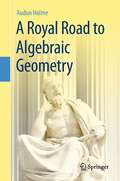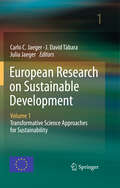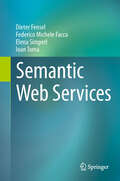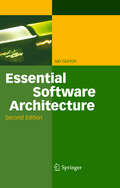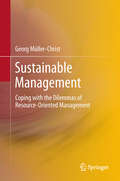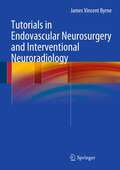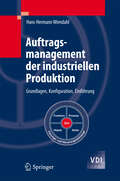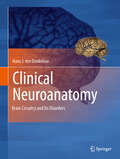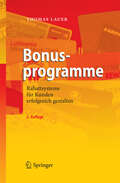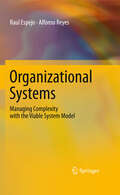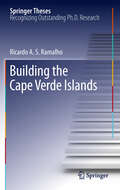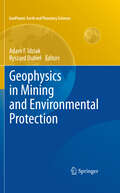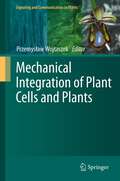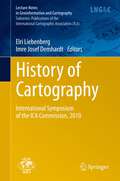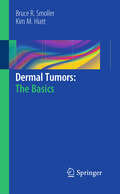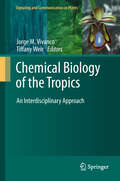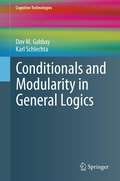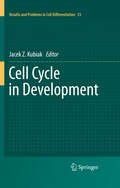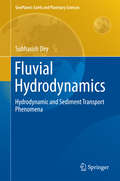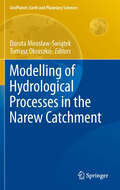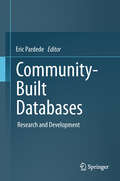- Table View
- List View
A Royal Road to Algebraic Geometry
by Audun HolmeThis book is about modern algebraic geometry. The title A Royal Road to Algebraic Geometry is inspired by the famous anecdote about the king asking Euclid if there really existed no simpler way for learning geometry, than to read all of his work Elements. Euclid is said to have answered: "There is no royal road to geometry!" The book starts by explaining this enigmatic answer, the aim of the book being to argue that indeed, in some sense there is a royal road to algebraic geometry. From a point of departure in algebraic curves, the exposition moves on to the present shape of the field, culminating with Alexander Grothendieck's theory of schemes. Contemporary homological tools are explained. The reader will follow a directed path leading up to the main elements of modern algebraic geometry. When the road is completed, the reader is empowered to start navigating in this immense field, and to open up the door to a wonderful field of research. The greatest scientific experience of a lifetime!
European Research on Sustainable Development
by J. David Tàbara Carlo C. Jaeger Julia JaegerThis book provides the reader with a state-of-the-art view of research on sustainable development. Its emphasis lies on the transformative dimension of this research: sustainable development can only be realized through a far-reaching transformation of the situation humankind finds itself in at the beginning of the third millennium. The contributions are written by leading world experts in the conceptualisation and actual practice of sustainable development. The book provides a timely overview of ideas and methods as well as a variety of original learning examples on the most innovative approaches on sustainability science.
Quantum Mechanics in the Geometry of Space-Time
by Roger BoudetThis book continues the fundamental work of Arnold Sommerfeld and David Hestenes formulating theoretical physics in terms of Minkowski space-time geometry. We see how the standard matrix version of the Dirac equation can be reformulated in terms of a real space-time algebra, thus revealing a geometric meaning for the "number i" in quantum mechanics. Next, it is examined in some detail how electroweak theory can be integrated into the Dirac theory and this way interpreted in terms of space-time geometry. Finally, some implications for quantum electrodynamics are considered. The presentation of real quantum electromagnetism is expressed in an addendum. The book covers both the use of the complex and the real languages and allows the reader acquainted with the first language to make a step by step translation to the second one.
Transcultural History
by Madeleine Herren Christiane Sibille Martin RüeschFor the 21st century, the often-quoted citation 'past is prologue' reads the other way around: The global present lacks a historical narrative for the global past. Focussing on a transcultural history, this book questions the territoriality of historical concepts and offers a narrative, which aims to overcome cultural essentialism by focussing on crossing borders of all kinds. Transcultural History reflects critically on the way history is constructed, asking who formed history in the past and who succeeded in shaping what we call the master narrative. Although trained European historians, the authors aim to present a useful approach to global history, showing first of all how a Eurocentric but universal historiography removed or essentialised certain topics in Asian history. As an empirical discipline, history is based on source material, analysed according to rules resulting from a strong methodological background. This book accesses the global past after World War I, looking at the well known stage of the Paris Peace Conferences, observing the multiplication of new borders and the variety of transgressing institutions, concepts, actors, men and women inventing themselves as global subjects, but sharing a bitter experience with almost all local societies at this time, namely the awareness of having relatives buried in far distant places due to globalised wars.
Semantic Web Services
by Dieter Fensel Elena Simperl Federico Michele Facca Ioan TomaA paradigm shift is taking place in computer science: one generation ago, we learned to abstract from hardware to software, now we are abstracting from software to serviceware implemented through service-oriented computing. Yet ensuring interoperability in open, heterogeneous, and dynamically changing environments, such as the Internet, remains a major challenge for actual machine-to-machine integration. Usually significant problems in aligning data, processes, and protocols appear as soon as a specific piece of functionality is used within a different application context. The Semantic Web Services (SWS) approach is about describing services with metadata on the basis of domain ontologies as a means to enable their automatic location, execution, combination, and use. Fensel and his coauthors provide a comprehensive overview of SWS in line with actual industrial practice. They introduce the main sociotechnological components that ground the SWS vision (like Web Science, Service Science, and service-oriented architectures) and several approaches that realize it, e.g. the Web Service Modeling Framework, OWL-S, and RESTful services. The real-world relevance is emphasized through a series of case studies from large-scale R&D projects and a business-oriented proposition from the SWS technology provider Seekda. Each chapter of the book is structured according to a predefined template, covering both theoretical and practical aspects, and including walk-through examples and hands-on exercises. Additional learning material is available on the book website www.swsbook.org. With its additional features, the book is ideally suited as the basis for courses or self-study in this field, and it may also serve as a reference for researchers looking for a state-of-the-art overview of formalisms, methods, tools, and applications related to SWS.
Essential Software Architecture
by Ian GortonJob titles like "Technical Architect" and "Chief Architect" nowadays abound in software industry, yet many people suspect that "architecture" is one of the most overused and least understood terms in professional software development. Gorton's book tries to resolve this dilemma. It concisely describes the essential elements of knowledge and key skills required to be a software architect. The explanations encompass the essentials of architecture thinking, practices, and supporting technologies. They range from a general understanding of structure and quality attributes through technical issues like middleware components and service-oriented architectures to recent technologies like model-driven architecture, software product lines, aspect-oriented design, and the Semantic Web, which will presumably influence future software systems. This second edition contains new material covering enterprise architecture, agile development, enterprise service bus technologies, RESTful Web services, and a case study on how to use the MeDICi integration framework. All approaches are illustrated by an ongoing real-world example. So if you work as an architect or senior designer (or want to someday), or if you are a student in software engineering, here is a valuable and yet approachable knowledge source for you.
Sustainable Management
by Georg Müller-ChristIn this book, a resource-oriented perception of sustainable management is presented. Firms that decide to act more sustainable have to bear in mind that they do not only need resources for economic activities today, but that they will need these tomorrow as well. This leads to contradictory management rationalities firms must deal with. The author presents his findings as regards the development of environmental and social responsibility and introduces a theory of management ecology. He takes a close look at the contradictions businesses have to face when governing their activity towards sustainability. Moreover, he identifies different notions of the resource term in management studies and develops a "sustainable resource management" which could help businesses redirect their economic activities from a solely profit-oriented to a resource-oriented way of operating.
Tutorials in Endovascular Neurosurgery and Interventional Neuroradiology
by James Vincent ByrneThis book aims to provide the trainee and practicing minimally invasive neurological therapist with a comprehensive understanding of the background science and theory that forms the foundation of their work. The contents are based on the tutorial teaching techniques used at the University of Oxford and are authored by the MSc Course Director. The tutorial is a learning episode focussed on a particular topic and intended to guide the student/reader through the background literature, to highlight the research on which standard practices are based and to provide the insights of an experienced practitioner. Each chapter of the book covers a different topic to build a complete review of the subspecialty, with in-depth discussion of all currently used techniques. The literature is reviewed and presented in context to illustrate its importance to the practice of this rapidly expanding field of medical treatment.
Auftragsmanagement der industriellen Produktion: Grundlagen, Konfiguration, Einführung (VDI-Buch)
by Hans-Hermann WiendahlMit der Globalisierung rückt die Logistik als Wettbewerbsfaktor für Produktionsunternehmen zunehmend in den Vordergrund. In dem Band wird erstmals ein ganzheitlicher, sozio-technischer Ansatz für das Auftragsmanagement in der industriellen Produktion vorgestellt, der die Wechselwirkungen zwischen Systemfunktionen, Nutzern und der Organisation berücksichtigt. Unter Einbeziehung dieser Aspekte wird die Gestaltung und Einführung eines Auftragsmanagement-Systems nachvollziehbar beschrieben und durch zahlreiche Bilder und Praxisbeispiele veranschaulicht.
Clinical Neuroanatomy: Brain Circuitry and Its Disorders
by Hans J. ten DonkelaarConnections define the functions of neurons: information flows along connections, as well as growth factors and viruses, and even neuronal death may progress through connections. Knowledge of how the various parts of the brain are interconnected to form functional systems is a prerequisite for the proper understanding of data from all fields in the neurosciences. Clinical Neuroanatomy: Brain Circuitry and Its Disorders bridges the gap between neuroanatomy and clinical neurology. It emphasizes human and primate data in the context of disorders of brain circuitry which are so common in neurological practice. In addition, numerous clinical cases demonstrate how normal brain circuitry may be interrupted and to what effect. Following an introduction into the organization and vascularisation of the human brain and the techniques to study brain circuitry, the main neurofunctional systems are discussed, including the somatosensory, auditory, visual, motor, autonomic and limbic systems, the cerebral cortex and complex cerebral functions.
Bonusprogramme: Rabattsysteme für Kunden erfolgreich gestalten
by Thomas LauerBonusprogramme haben seit der Abschaffung des Rabattgesetzes auch den deutschsprachigen Raum erobert. Wie können Unternehmen davon profitieren? Das Standardwerk liefert einen vollständigen und systematischen Überblick zu allen Aspekten und zeigt, wie Kundenbonusprogramme gestaltet werden können. Mit Fallbeispielen und Checklisten zur Konzeption, Einführung und Optimierung von Bonusprogrammen und Rabattsystemen. Die 2. Auflage wurde aktualisiert und um Abschnitte zu den psychologischen Grundlagen, zu Rechtsfragen und empirischen Studien ergänzt.
Organizational Systems: Managing Complexity with the Viable System Model
by Alfonso Reyes Raul EspejoOrganizational Systems clarifies the application of cybernetic ideas, particularly those of Beer's Viable System Model, to organizational diagnosis and design. Readers learn to appreciate the relevance of seeing the systemic coherence of the world. The book argues that many of the problems we experience today are routed in our practice of fragmenting that needs to be connected as a whole. It offers a method to study and design organizations and a methodology to deal with implementation problems. It is the outcome of many years of working experience with government offices as well as with all kinds of public and private enterprises. At a more detailed level this book offers an in depth discussion of variety engineering that is not available either in the primary or secondary literature.
Plant Desiccation Tolerance
by Erwin Beck Ulrich Lüttge Dorothea BartelsDesiccation tolerance was essential when plants first began to conquer land, roughly 400 million years ago. While most desiccation-tolerant plants belong to basal phylogenetic taxa, this capacity has also evolved among some vascular plant species. In this volume renowned experts treat plant desiccation tolerance at the organismic as well as at the cellular level. The diversity of ecophysiological adaptations and acclimations of cyanobacteria, eukaryotic algae, mosses, and lichens is addressed in several chapters. The particular problems of vascular plants during dehydration/rehydration cycles resulting not only from their hydraulic architectures, but also from severe secondary stresses associated with the desiccated state are discussed. Based on the treatment of desiccation tolerance at the organismic level, a second section of the book is devoted to the cell biological level. It delineates the general concepts of functional genomics, epigenetics, genetics, molecular biology and the sensing and signalling networks of systems biology involved in dehydration/rehydration cycles. This book provides an invaluable compilation of current knowledge, which is a prerequisite for a better understanding of plant desiccation tolerance in natural as well as agro- and forest ecosystems where water is one of the most essential resources.
Building the Cape Verde Islands (Springer Theses)
by Ricardo A. RamalhoHotspots are enigmatic surface features that are not easily explained in the framework of plate tectonics. Investigating their origin is the goal of this thesis, using field evidence collected in the Cape Verde Islands, a prominent hotspot archipelago in the eastern Atlantic Ocean. The approach taken is to document uplift of the islands relative to sea level and use the uplift features to test various models of hotspot development. Island uplift is thought to arise from the growth of the anomalously shallow seafloor on which the islands rest, known as the bathymetric swell, which is characteristic of hotspots. The work comprises a geological summary and detailed mapping of paleo sea level markers on Cape Verde. Isotopic dating of the markers shows that uplift on the islands over the last 6 Myr is up to 400 m, and that the uplift chronology varies among islands. Two processes act to raise the Cape Verde Islands. The dominant process is one that is local to individual islands. The regional, swell-related component is smaller, and possibly episodic. The observations provide strong constraints on swell development and on hotspot models.
Real Estate Investments in Germany
by Jutta C. Möller Michael Mütze Thomas SenffThe real estate market in Germany has recovered remarkably well from 2008/09 crisis. Portfolio transactions, infrastructure projects as well as investments in commercial and residential real estate are on the rise. This publication provides investors, property developers and advisers with a practical guideline to the legal, tax and commercial framework for real estate investments in Germany.
Geophysics in Mining and Environmental Protection
by Adam F. Idziak Ryszard DubielThis book contains contributions to the 32nd Polish-Czech-Slovak Symposium on Mining and Environmental Geophysics held in May 2009 in Piechowice (Poland). The papers are related to various aspects of geophysical science such as induced seismicity, engineering seismology, environmental geophysics and geophysics in geology
Mechanical Integration of Plant Cells and Plants
by Przemyslaw WojtaszekChemical reactions and interactions between molecules are commonly considered the basis of life, and thus the biochemical nature of cells and organisms is relatively well recognized. Research conducted in recent years, however, increasingly indicates that physical forces profoundly affect the functioning of life at all levels of its organization. To detect and to respond to such forces, plant cells and plants need to be structured mechanically. This volume focuses on mechanical aspects of plant life. It starts with a consideration of the mechanical integration of supracellular structures and mechanical properties of cellular building blocks to show how the structural integrity of plant cells is achieved and maintained during growth and development. The following chapters reveal how the functioning of integrated plant cells contributes to the mechanical integration of plants, and how the latter are able to detect physical stimuli and to reorganize their own cells in response to them. The mechanical aspects of plant responses to stresses are also presented. Finally, all these aspects are placed in an evolutionary context.
History of Cartography
by Elri Liebenberg Imre Josef DemhardtThis volume comprises the proceedings of the 2010 International Symposium of the ICA Commission on the History of Cartography. The nineteen papers reflect the research interests of the Commission which span the period from the Enlightenment to the evolution of Geographical Information Science. Apart from studies on general cartography, the volume, which reflects some co-operation with the ICA Commission on Maps and Society and the United States Geological Survey (USGS), contains regional studies on cartographic endeavours in Northern America, Brazil, and Southern Africa.The ICA Commission on Maps and Society participated as its field of study often overlaps with that of the ICA Commission on the History of Cartography. The USGS which is the official USA mapping organisation, was invited to emphasise that the ICA Commission on the History of Cartography is not only interested in historical maps, but also has as mandate the research and document the history of Geographical Information Science. The ICA Commission on Maps and Society participated as its field of study often overlaps with that of the ICA Commission on the History of Cartography. The USGS which is the official USA mapping organisation, was invited to emphasise that the ICA Commission on the History of Cartography is not only interested in historical maps, but also has as mandate the research and document the history of Geographical Information Science.
Dermal Tumors: The Basics
by Bruce R. Smoller Kim M. HiattDermal Tumors: The Basics will serve as an effective and efficient handbook for the student of dermatopathology, and as a practical bench reference for the practicing diagnostician who desires rapid access to criteria that are useful in differentiating histologically similar entities. The reader will be able to focus upon a single histologic observation, i.e., inflammatory conditions without epidermal changes, and use this as a starting point from which to build a differential diagnosis based upon pattern recognition. As each entity is addressed, there will be a concise discussion of the basic clinical findings and epidemiologic associations. This will be followed by a histologic description, highlighting areas that serve to discriminate between the entity under discussion and similar ones. Any immunologic studies that might augment the diagnostic sensitivity or specificity will be discussed. The chapters are thematically based and consist of essential bullet points arranged in organized outlines allowing for easy access and direct comparison between entities. The salient histologic features are depicted with abundant high quality, full-color photomicrographs placed immediately adjacent to the appropriate histologic bullet points. This volume will serve as an effective and efficient handbook for the student of dermatopathology, and as a practical bench reference for the practicing diagnostician who desires rapid access to criteria that are useful in differentiating histologically similar entities. The elaborate pictorial documentation will also enable the book to serve as an atlas of the commonest dermatologic disorders.
Chemical Biology of the Tropics: An Interdisciplinary Approach (Signaling and Communication in Plants #8)
by Tiffany Weir Jorge M. VivancoThe mystique of the rainforest has captured the imaginations of generations of young people, explorers, authors, and biologists. It is a delicate ecosystem whose myriad sounds and smells, whose vibrancy of life, is balanced by constant cycles of death and decay. It is a place of fierce competition where unusual partnerships are forged and creative survival strategies are the norm. In this book, you will meet the scientific pioneers who first attempted to quantify and understand the vast diversity of these tropical forests, as well as their successors, who utilize modern tools and technologies to dissect the chemical nature of rainforest interactions. This book provides a general background on biodiversity and the study of chemical ecology before moving into specific chemical examples of insect defenses and microbial communication. It finishes with first-hand accounts of the trials and tribulations of a canopy biology pioneer and a rainforest research novice, while assessing the state of modern tropical research, its importance to humanity, and the ecological, political, and ethical issues that need to be tackled in order to move the field forward.
Conditionals and Modularity in General Logics (Cognitive Technologies)
by Dov M. Gabbay Karl SchlechtaThis text centers around three main subjects. The first is the concept of modularity and independence in classical logic and nonmonotonic and other nonclassical logic, and the consequences on syntactic and semantical interpolation and language change. In particular, we will show the connection between interpolation for nonmonotonic logic and manipulation of an abstract notion of size. Modularity is essentially the ability to put partial results achieved independently together for a global result. The second aspect of the book is the authors' uniform picture of conditionals, including many-valued logics and structures on the language elements themselves and on the truth value set. The third topic explained by the authors is neighbourhood semantics, their connection to independence, and their common points and differences for various logics, e.g., for defaults and deontic logic, for the limit version of preferential logics, and for general approximation. The book will be of value to researchers and graduate students in logic and theoretical computer science.
Cell Cycle in Development (Results and Problems in Cell Differentiation #53)
by Jacek Z. KubiakThis book focuses on the intersection between cell cycle regulation and embryo development. Specific modifications of the canonical cell cycle occur throughout the whole period of development and are adapted to fulfil functions coded by the developmental program. Deciphering these adaptations is essential to comprehending how living organisms develop. The aim of this book is to review the best-known modifications and adaptations of the cell cycle during development. The first chapters cover the general problems of how the cell cycle evolves, while consecutive chapters guide readers through the plethora of such phenomena. The book closes with a description of specific changes in the cell cycle of neurons in the senescent human brain. Taken together, the chapters present a panorama of species - from worms to humans - and of developmental stages - from unfertilized oocyte to aged adult.
Fluvial Hydrodynamics
by Subhasish DeyThe state-of-the-art in fluvial hydrodynamics can be examined only through a careful exploration of the theoretical development and applied engineering technology. The book is primarily focused, since most up-to-date research findings in the field are presented, on the research aspects that involve a comprehensive knowledge of sediment dynamics in turbulent flows. It begins with the fundamentals of hydrodynamics and particle motion followed by turbulence characteristics related to sediment motion. Then, the sediment dynamics is analysed from a classical perspective by applying the mean bed shear approach and additionally incorporating a statistical description for the role of turbulence. The work finally examines the local scour problems at hydraulic structures and scale models. It is intended to design as a course textbook in graduate / research level and a guide for the field engineers as well, keeping up with modern technological developments. Therefore, as a simple prerequisite, the background of the readers should have a basic knowledge in hydraulics in undergraduate level and an understanding of fundamentals of calculus.
Modelling of Hydrological Processes in the Narew Catchment
by Dorota Świątek Tomasz OkruszkoSince climate and land use strongly affect the runoff pattern and intensity of solute export, it is likely that some observations and conclusions formulated on the basis of investigations carried out in forested catchment may not be fully adequate to describe controls on solute export from agricultural watersheds. The primary objective of the present research is to better understand the flow paths that affect the fluxes of dissolved compounds from a small agricultural catchment during snowmelt. This book focuses on spring snowmelt, because this is the dominant hydrological event in many moderate and high latitude catchments and, thus, is regarded as a prominent factor influencing the quality of surface waters
Community-Built Databases: Research and Development
by Eric PardedeWikipedia, Flickr, You Tube, Facebook, LinkedIn are all examples of large community-built databases, although with quite diverse purposes and collaboration patterns. Their usage and dissemination will further grow introducing e.g. new semantics, personalization, or interactive media. Pardede delivers the first comprehensive research reference on community-built databases. The contributions discuss various technical and social aspects of research in and development in areas like in Web science, social networks, and collaborative information systems. Pardede delivers the first comprehensive research reference on community-built databases. The contributions discuss various technical and social aspects of research in and development in areas like in Web science, social networks, and collaborative information systems.
